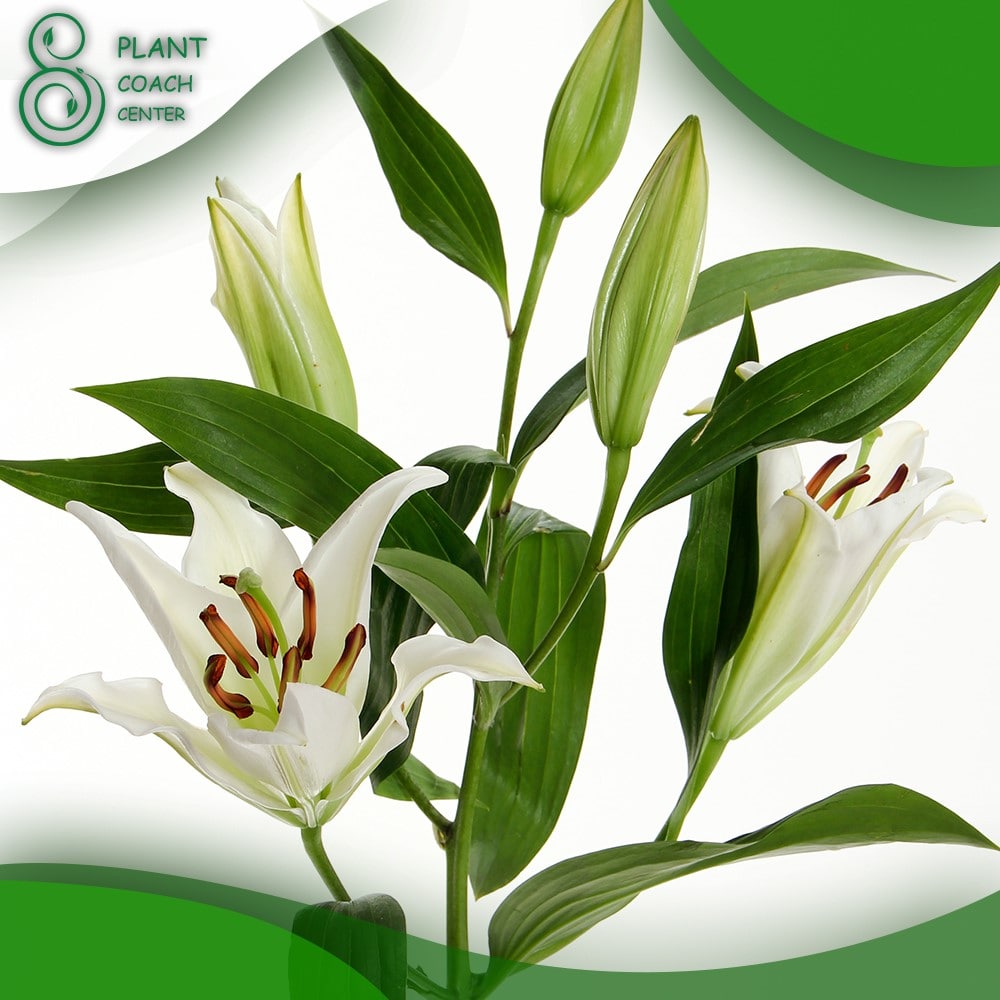When to Divide Lilies?
Welcome to the world of lilies, where elegance and exuberance intertwine to create captivating blooms that adorn our gardens and indoor spaces. As a lily enthusiast, you’re likely well-acquainted with these flowers’ breathtaking beauty, but have you ever wondered about the secret to their perennial splendor?
The answer lies in the ancient horticultural practice of lily division – a technique that rejuvenates these botanical marvels and multiplies their charm. Imagine a single lily plant transforming into a vibrant blossom tapestry, enhancing your garden’s allure and gardening prowess.
In this exploration of “When to Divide Lilies,” we embark on a journey through the seasons, unraveling the art and science behind proper division timing, techniques that ensure successful separation, and the careful nurturing required for these new beginnings to flourish. Whether you’re a seasoned green thumb or just beginning to embrace the world of plants, this guide will empower you to harness the magic of lily division and witness nature’s remarkable ability to rejuvenate, thrive, and enchant.
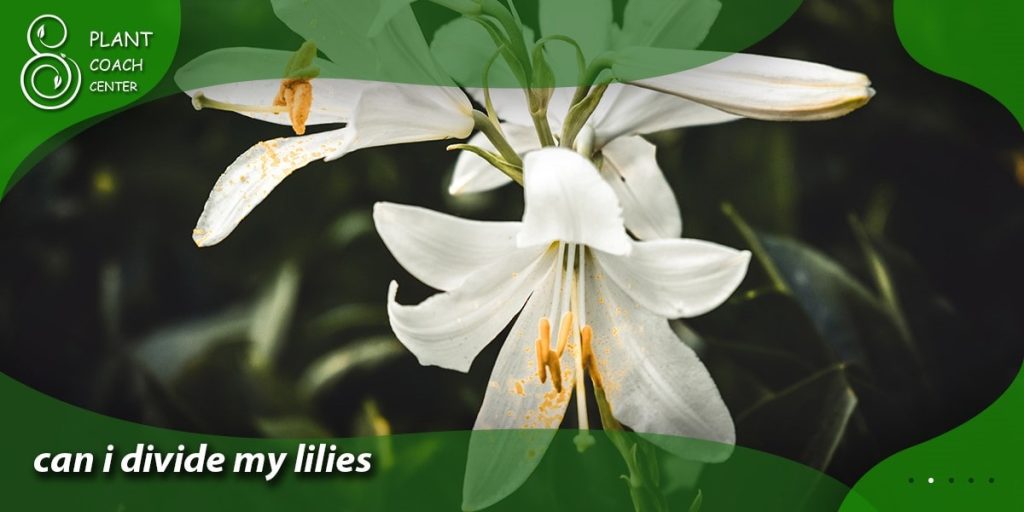
The Art of Lily Division: Uncovering the Benefits and Techniques
Lily division, often regarded as the horticultural equivalent of creating art, is a practice that extends beyond gardening into rejuvenation and creativity. At its core, lily division is the careful process of separating a mature lily plant into smaller, independent sections, each with the potential to grow into a robust and radiant individual. This practice serves multiple purposes, ranging from enhancing the overall health of the lily bed to multiplying the number of lilies in your collection.
One of the primary benefits of lily division is its rejuvenating effect on the plants. Over time, a lily plant’s vigor can diminish as it competes for resources with its crowded roots. Dividing the plant allows you to refresh its growing environment, providing more space, nutrients, and aeration for each section. Moreover, lily division is a strategy to propagate and create new plants without relying on seeds. This method ensures that the new plants retain the exact characteristics of the parent plant, maintaining the integrity of the original cultivar.
The technique behind successful lily division involves a delicate balance of timing, precision, and care. The ideal time to divide lilies generally falls within the dormant season, either in early spring as new growth begins or in late summer/early fall after the flowering period. During these times, the plants are less stressed, making it easier to recover from the division process.
To begin, carefully dig up the lily clump, not damaging the roots. Gently shake off excess soil to reveal the bulb clusters, and then use a clean, sharp knife to separate the bulbs, ensuring that each section has roots and healthy shoots. Be cautious not to break or injure the bulbs during the separation process. After division, it’s essential to promptly plant the newly separated bulbs in well-prepared soil, ensuring they’re at the appropriate depth and adequately watered.
Timing for Triumph: Discovering the Perfect Season to Divide Your Lilies
Timing plays a pivotal role in the success of the lily division, as choosing the right season can make all the difference between a triumphant transformation and a lackluster outcome. The natural growth cycle of lilies dictates the optimal periods for division, ensuring the plants have the best chance to recover and flourish.
Early spring and late summer to early fall are critical windows for the lily division. Early spring, just as new growth begins, is an excellent time to divide your lilies. The plant’s energy is redirected towards establishing new shoots, making it more resilient to the division process. This period also allows the newly divided sections ample time to establish their root systems before the next growing season.
In late summer or early fall, lilies enter a dormant phase after the flowering has concluded. This dormancy provides a less stressful environment for the division process, as the plant’s energy is focused on root development rather than top growth. Dividing during this time gives the new sections several months to establish themselves before the next spring’s growth cycle.
While these two main periods are ideal for division, it’s essential to consider your specific climate and lily variety. Different lily species and cultivars may have slight variations in their growth cycles, which could affect the most suitable time for division. Additionally, local climate conditions, such as frost dates and temperature fluctuations, should be considered to avoid undue stress on the newly divided plants.
In essence, timing truly is the key to triumph when it comes to lily division. By carefully observing your lilies’ growth patterns, understanding their dormant phases, and aligning your division efforts with the most conducive seasons, you ensure they survive and thrive, showcasing their resplendent beauty as a testament to your strategic gardening finesse.
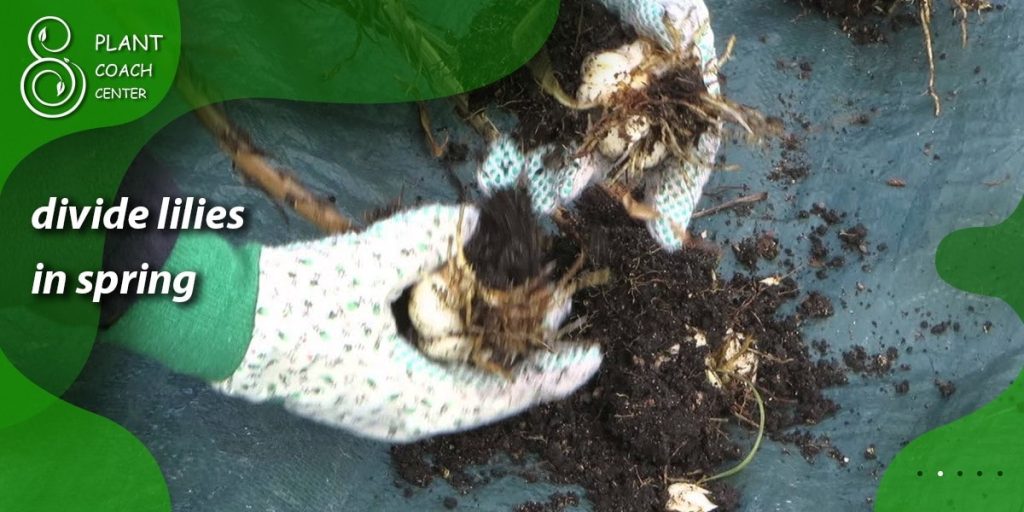
Signs of Separation: How to Recognize When Your Lilies Are Ready to Be Divided
Dividing lilies at the right time is a delicate balance between nurturing a thriving garden and understanding the subtle signals that your plants give you. Recognizing the signs that your lilies are ready for separation involves a keen eye and a deep understanding of their growth patterns.
Overcrowding and Reduced Blooming
One of the most evident signs that your lilies are due for division is overcrowding within the planting bed. When lilies become too tightly packed, competition for resources can result in smaller blooms, fewer flowers, and decreased overall vitality. If you’ve noticed a decline in the quality and quantity of blooms compared to previous years, it’s likely time to consider division.
Sparse Foliage and Weak Growth
Lilies that once exhibited robust growth may show signs of weakness. Sparse foliage, fewer stems, or thinner growth are indicators that the plant’s root system is struggling to sustain its needs. Dividing the lilies and providing them with more space and resources can help rejuvenate their growth.
Overgrown Clumps
As lilies age, their bulbs multiply and create clumps. While this is natural, huge clumps can hinder the plant’s overall health. If you find that the bulbs are densely packed and intertwined, causing difficulty in separating them, it’s a clear sign that division is overdue.
Reduced Flower Size
If your lilies used to produce large, vibrant flowers but have recently been yielding smaller, less impressive blooms, this can result from overcrowding. Dividing the plants and giving them more room to thrive can lead to a resurgence in flower size and quality.
Decline in Overall Vigor
Lilies that were once vigorous, showcasing solid stems and healthy foliage, might exhibit a decline in their overall vitality. This decline can manifest as pale or yellowing leaves, stunted growth, or increased susceptibility to pests and diseases. Dividing and rejuvenating the plants can help restore their vigor.
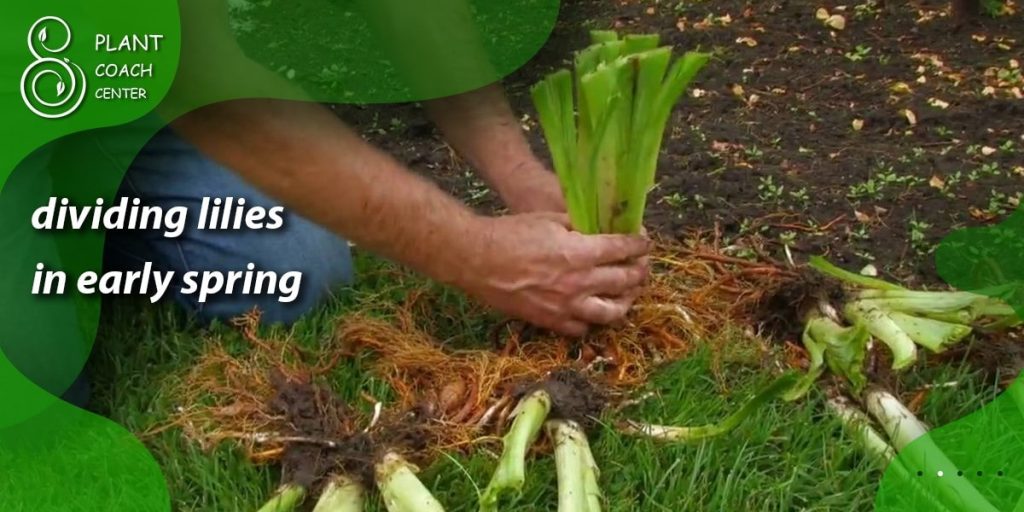
Preparing for Prosperity: Steps to Take Before and After Dividing Your Lilies
Dividing lilies is not only an act of horticultural prowess but also a process that requires careful preparation and aftercare to ensure the prosperity of the newly separated plants. From readying the plants for division to nurturing their growth post-separation, each step contributes to the success of this transformative endeavor.
Before Division
Choose the Right Tools: Before beginning the division journey, gather the necessary tools, including a sharp and clean knife, gloves, a spade, and suitable containers for the divided bulbs. Having everything ready ensures a seamless process.
Water the Plants: Hydrated plants are better equipped to handle the stress of division. Water the lilies thoroughly a day or two before the planned division. Moist soil makes it easier to dig up the clumps without causing excessive root damage.
Prepare the New Planting Site: Prepare the soil beforehand, whether replanting the divisions in the same bed or a different location. Loosen the soil and incorporate organic matter to improve drainage and fertility.
During Division
Gentle Separation: Carefully dig up the lily clump, not damaging the bulbs. Gently shake off excess soil to expose the bulbs, then use a sharp knife to separate them. Ensure that each section has roots and healthy shoots.
Divide With Precision: Pay attention to the natural divisions between bulbs. Avoid cutting too close to the bulbs, which can lead to injury. Aim to create separate sections with several bulbs each, ensuring they have room to grow.
After Division
Plant Immediately: Divided bulbs should be planted as soon as possible to prevent them from drying out. Place them in the prepared planting holes at the appropriate depth, taking care not to plant them too deeply.
Water and Mulch: Water the newly planted divisions thoroughly to settle the soil around the bulbs. Apply a layer of mulch to help retain moisture, regulate soil temperature, and suppress weed growth.
Monitor and Maintain: Keep a watchful eye on the newly divided plants. Regularly water them to keep the soil consistently moist but not waterlogged. Monitor for signs of stress, pests, or diseases and address them promptly.
Fertilize with Caution: While providing extra nutrients is tempting, refrain from heavy fertilization immediately after division. Fertilize sparingly to avoid overwhelming the plants during their recovery phase.
Lilies in Transition: Nurturing and Monitoring Divided Plants for Optimal Growth
As you embark on the journey of lily division, it’s essential to understand that the process isn’t complete once the bulbs are separated and planted. The period of transition that follows is a critical phase that requires attentive care and nurturing. This phase is when the newly divided lilies adapt to their new environment and establish themselves for future growth.
Establishing Roots
During the transition, the divided lilies will be focused on establishing their root systems. Adequate moisture is essential to help the roots develop and anchor the plants securely in the soil. Regular watering is crucial, ensuring the soil remains consistently moist but not waterlogged. Mulch also plays a pivotal role by retaining moisture, moderating soil temperature, and preventing weed competition.
Monitoring Growth
Closely monitor the growth of your divided lilies during this phase. While some temporary stress is natural after division, keep an eye out for signs of distress such as wilting, yellowing leaves, or slowed growth. These may indicate that the plants need more water or are experiencing shock from the division process. Adjust your care regimen accordingly.
Fostering Vigor
To foster the vigor of your lilies in transition, consider applying a balanced, slow-release fertilizer a few weeks after planting. This will provide a gentle nutrient boost without overwhelming the plants. Avoid heavy nitrogen-based fertilizers, as they might encourage excessive leaf growth at the expense of flower development.
Removing Spent Flowers
If your lilies were divided after flowering, removing any spent flowers is a good idea to redirect the plant’s energy towards root and bulb development. However, if your lilies were divided before flowering, allow them to bloom as usual.
Planning for the Next Season
Start planning for the upcoming growing season as your divided lilies transition and establish themselves. Take note of the variety and colors of lilies in your garden, and consider how you can arrange them for maximum visual impact. Plan for staking, especially for taller lily varieties, to support their growth as they mature.
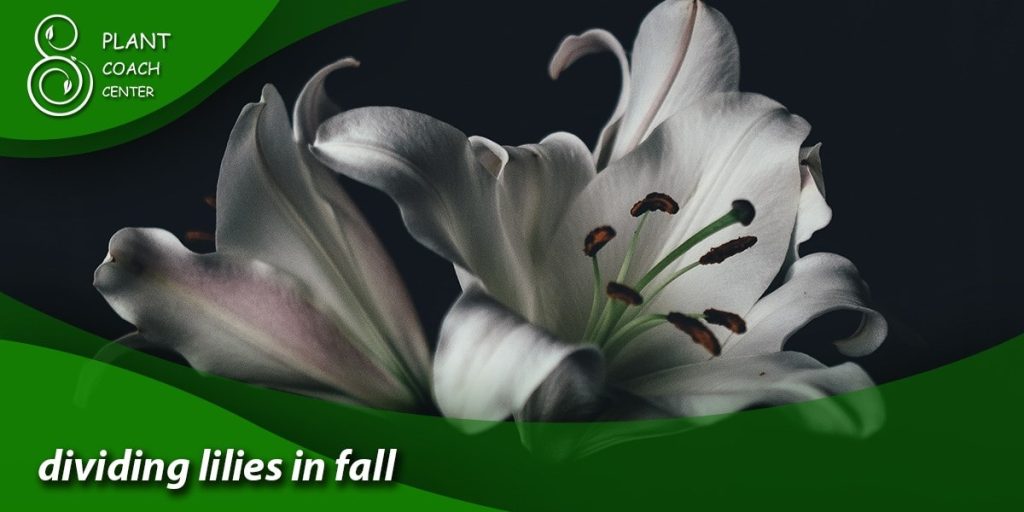
Species Spotlight: Tailoring Lily Division Strategies for Different Lily Varieties
While lily division follows a general set of guidelines, it’s essential to recognize that different lily species and cultivars may have unique characteristics that influence the timing and techniques of division. Understanding these distinctions will help you tailor your approach for optimal results and the continued health of each lily variety.
Asiatic Lilies
Asiatic lilies are known for their early bloom times and vibrant colors. They are best divided in early spring, just as new growth begins. Their root systems are generally shallow, so don’t plant them too profoundly when dividing. Be cautious with waterlogging the soil, as they prefer well-draining conditions.
Oriental Lilies
Oriental lilies are famous for their large, fragrant flowers that bloom later in the season. Dividing Oriental lilies can be done in late summer to early fall after their flowering period. These lilies tend to have a deeper root system, so ensure that the planting hole accommodates their longer roots.
Trumpet and Aurelian Lilies:
Trumpet and Aurelian lilies are known for their trumpet-shaped flowers and tall growth habit. Dividing these lilies is best done in early spring, and they appreciate well-draining soil and protection from strong winds due to their height.
Martagon Lilies
Martagon lilies are unique with their downward-facing flowers and whorled leaves. They prefer slightly acidic soil and are best divided in early spring while still dormant. When replanting, keep their bulbs shallow, as they tend to grow closer to the surface.
Species Hybrids and Wild Lilies
For species hybrids and wild lilies, research the natural habitat of the parent species to understand their growth patterns and division preferences. These lilies often thrive when their division techniques mimic their native conditions.
Adapting to Your Climate
It’s essential to consider your local climate when dividing lilies. In colder climates, where frost arrives early, division in late summer might be more suitable to allow the newly divided bulbs enough time to establish their roots before winter. In milder climates, early spring division can work well.
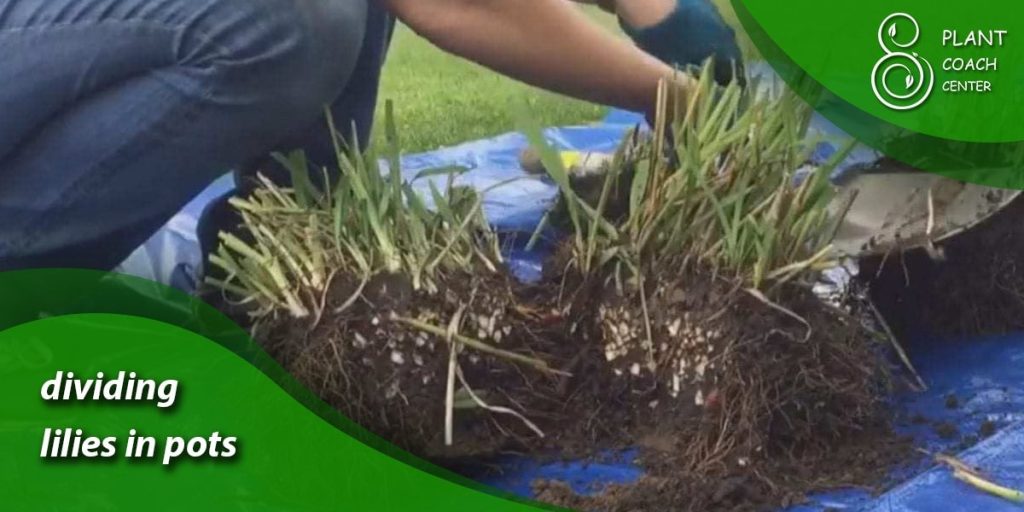
Conclusion
In the artful journey of lily division, we’ve uncovered a world where science and patience intertwine to create flourishing tapestries of botanical marvels. By recognizing the signs of separation, understanding optimal timing, and offering meticulous care during the transition, we lay the groundwork for the prosperity of these remarkable plants.
Whether entranced by the elegance of Asiatic lilies, captivated by the fragrance of Oriental lilies, or charmed by the unique characteristics of various species, tailoring your approach elevates your gardening expertise. At PlantCouchCenter.com, we celebrate this intricate dance between horticulture and creativity. As you embrace the art of lily division, you embark on a journey that nurtures growth, renews vitality, and celebrates the enduring beauty of nature’s canvas.
When should I divide lilies?
Early spring or late summer/early fall.
How do I know if my lilies need dividing?
Reduced blooming, overcrowding, weak growth.
Can I divide different lily species at the same time?
Each species has unique division preferences.


